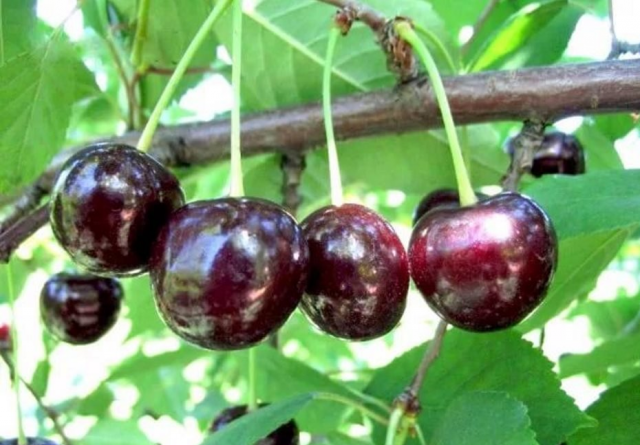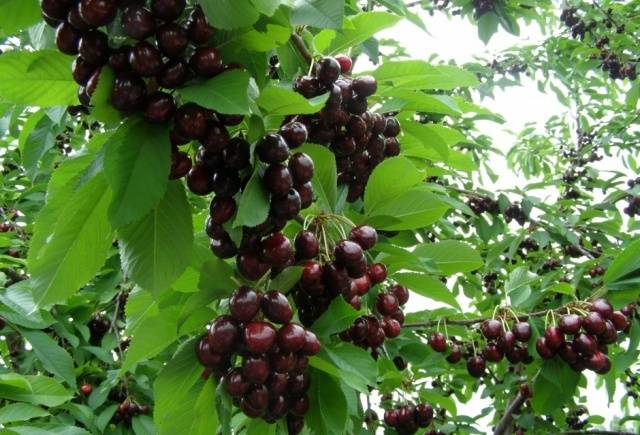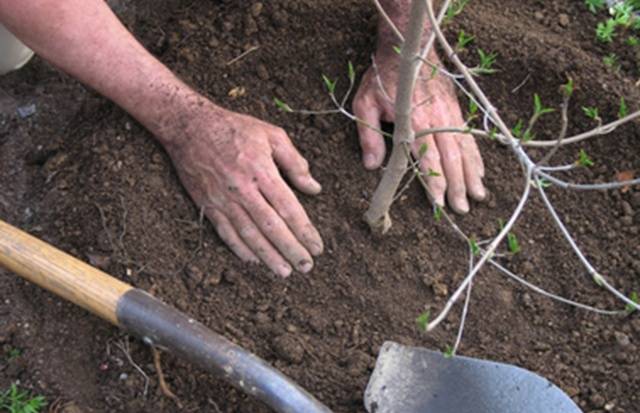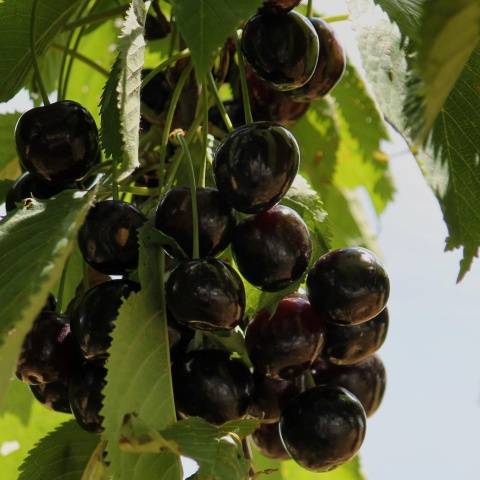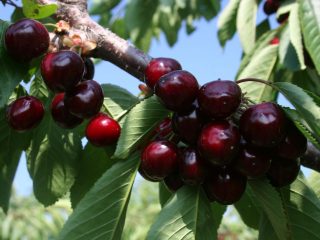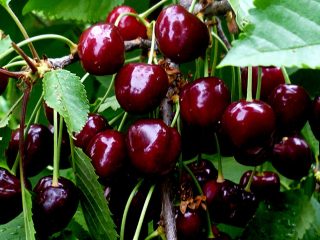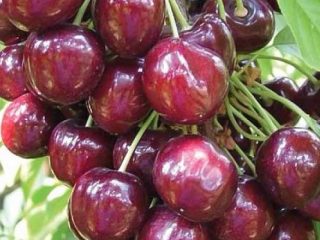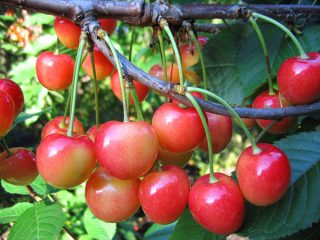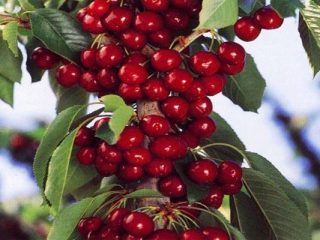Content
French Black cherry is a famous variety that is grown in the southern regions. Its main advantages are resistance to diseases and high quality fruits.
History of selection
The exact origin of the variety has not been established. It is believed that it was brought from Western Europe. Information about the variety has been present in the state register since 1959.
Description of culture
Description of the French Black cherry variety:
- great growth power;
- the crown is wide, spreading, round in shape;
- shoots branch well, hang slightly to the ground;
- annual branches are light brown with a gray coating;
- leaves are oval, measuring about 16x78 mm;
- the leaf blade is smooth, oval or elongated, dark green;
- the tips of the leaves are pointed.
Cherries produce medium-sized white flowers. Flowers bloom in inflorescences of 2-4 pieces.
The fruits are large, average weight 6.5 g, maximum - 7.5 g.The shape is elongated oval, with a small funnel, size 24x23 mm. The color is dark red, becoming more saturated when ripe, almost black.
The pulp is rich red, juicy, and high density. Taste qualities are rated 4.5 points. The juice is sweet, dark red.
The fruits have high commercial properties, do not crack, and the stem comes off easily. The pulp contains dry substances (13.3%), sugars (18.5%), acids (0.8%), ascorbic acid (7.7 mg/100 g).
According to its characteristics, the French Black cherry variety is suitable for planting in the North Caucasus and other southern regions.
Characteristics
When choosing a cherry variety, pay attention to its characteristics: resistance to drought, winter frosts and diseases, flowering period and fruit ripening.
Drought resistance, winter hardiness
The French Black variety is highly resistant to drought. The tree receives moisture after rains or from deep layers of soil.
Cherry shows high winter hardiness of buds and wood. With an early drop in temperature at the end of autumn, fruit buds suffer. According to reviews of the French Black cherry, the fruit buds are not susceptible to frost.
Pollination, flowering period and ripening time
The variety is self-sterile; pollinators must be planted to obtain a harvest. The best pollinators for French Black cherries are the Melitopolskaya, Krupnoplodnaya, Krasa Kubani, Black Napoleon, Ramon Oliva, and Prestizhnaya varieties.
Flowering occurs in May. The fruits ripen late. The harvest is harvested at the end of July.
Productivity, fruiting
French Black cherry begins to bear fruit in 6-7 years. The trees bear fruit for a long time, lasting 25 years.
Sweet cherries stand out for their high and stable yields.The largest yield (about 65 kg) is produced by a tree aged 15 years. The maximum recorded yield is 184 kg.
Area of application of berries
The fruits have a universal purpose. They are used as dessert and decoration for confectionery products. Cherries are frozen or processed to produce homemade preparations (jam, juice, compote).
Resistance to diseases and pests
The variety is not susceptible to the main fungal diseases of the crop: coccomycosis, moniliosis, hole spot. Resistance to pests is at an average level.
Advantages and disadvantages
Main advantages:
- high winter hardiness;
- stable yield;
- large fruits;
- high commercial and taste qualities of cherries.
Disadvantages of the French Black variety:
- exposure to early winter frosts;
- tree vigor.
Landing Features
Cherries are planted at a specified time, depending on weather conditions in the region. Pre-select a location, prepare a seedling and a planting hole.
Recommended timing
In warm regions, work is carried out in the fall after leaf fall. The seedling manages to take root before the onset of cold weather. In the middle zone, planting is postponed until spring, before the buds swell.
Choosing a suitable location
For cherries, choose a sunny, warm area. The crop is not planted in lowlands where moisture and cold air accumulate. The permissible groundwater level is more than 2 m.
Cherries prefer loamy or sandy loam soil. Coarse sand is added to clay soil, and organic matter is added to sandy soil.
What crops can and cannot be planted next to cherries?
Cherries are planted in groups of 2-4 varieties. It is not recommended to grow raspberries, currants, and hazels next to the crop.Cherries are removed 3-4 m from apple trees, pear trees and other fruit crops.
Selection and preparation of planting material
One- or two-year-old seedlings are suitable for planting. Before purchasing, inspect the shoots and root system. Healthy planting material does not have cracks, mold or other defects.
2 hours before planting, the roots of the seedling are immersed in clean water. If the root system is dried, it is kept in water for 10 hours.
Landing algorithm
Planting procedure:
- Dig a hole 1 m in diameter and 70 cm deep.
- Compost, 150 g of superphosphate, 50 g of viburnum salt and 0.5 kg of ash are added to the fertile soil.
- Part of the soil is poured into the hole and waited until it shrinks.
- After 2-3 weeks, the remaining soil is poured and a seedling is placed on top.
- The roots of the cherry tree are covered with soil and the plant is watered abundantly.
Subsequent care of the crop
Cherries are watered three times during the season: before flowering, in mid-summer and before winter. Each tree requires 2 buckets of water.
The French Black variety is fed in early spring. 15 g of urea, superphosphate and potassium sulfate are embedded in the soil. After harvesting, the tree is sprayed with a solution containing 10 g of phosphorus and potassium fertilizer per 10 liters of water.
When growing French Black cherries, pruning is carried out annually. The conductor and skeletal branches are shortened. Dry, frozen shoots that thicken the crown are cut off.
Only young trees need shelter for the winter. They are covered with agrofibre and spruce branches. To protect the trunk from rodents, use roofing felt or mesh.
Diseases and pests, methods of control and prevention
The main diseases of the crop are given in the table:
Name of the disease | Symptoms | Ways to fight | Preventive actions |
Chlorosis | Uniform yellowing of leaves ahead of schedule. | Spraying a tree with Bordeaux mixture. |
|
Clusterosporiasis | Small reddish spots on the leaves. | Treatment with a solution of the drug Abiga Peak. |
Cherry pests are listed in the table:
Pest | Signs of defeat | Ways to fight | Preventive actions |
leaf roller | Leaf roller caterpillars eat leaves, buds and fruits. | Spraying with a solution of the Coragen insecticide. |
|
Cherry pipe maker | The larvae feed on the core of the seed; as a result, the fruits fall off and lose their marketability and taste. | Treatment with Aktara. |
Conclusion
French Black Cherry is a proven variety suitable for planting in warm climates. The high marketability and taste of the fruits were appreciated by gardeners and farm owners.
Reviews
